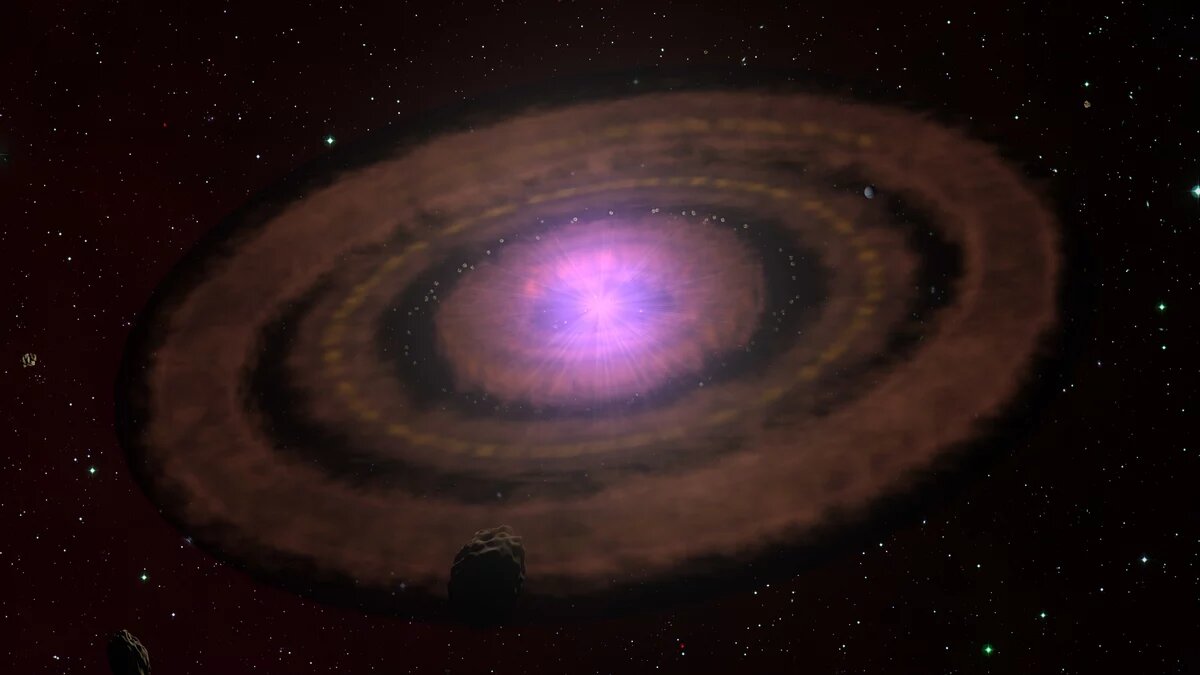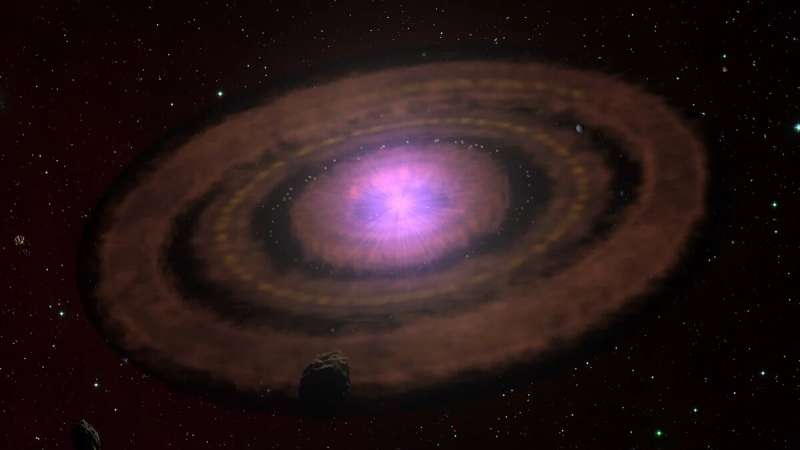

A group of astronomers, led by Sierk van Terwisga from the Max Planck Institute for Astronomy, have analyzed the mass distribution of over 870 planet-forming disks in the Orion A cloud. By exploiting the statistical properties of this unprecedented large sample of disks and developing an innovative data processing scheme, they found that far away from harsh environments like hot stars, the decline in disk mass only depends on their age. The results indicate that, at least within 1000 light-years of the Earth, planet-forming disks and planetary systems evolve in similar ways.
Some of the most exciting questions in present-day astronomical research are “What do other planetary systems look like?” and “How comparable is the solar system to other planetary systems?” A team of astronomers have now contributed crucial clues to solving this puzzle.
“Up to now, we didn’t know for sure which properties dominate the evolution of planet-forming disks around young stars,” says Sierk van Terwisga, who is a scientist at the Max Planck Institute for Astronomy in Heidelberg, Germany. He is the lead author of the underlying research article published in Astronomy & Astrophysics today. “Our new results now indicate that in environments without any relevant external influence, the observed disk mass available for forming new planets only depends on the age of the star-disk system,” van Terwisga adds.
The disk mass is the key property when studying the evolution of planet-forming disks. This quantity determines how much material is available to be transformed into planets. Depending on the disk age, it may also provide clues about the planets already present there. External effects like irradiation and winds from nearby massive stars obviously impact the disk survival. However, such environments are rare, and those processes do not reveal much about the disks themselves. Instead, astronomers are more interested in internal disk properties such as age, chemical composition, or the parental cloud dynamics from which the young stars with their disks emerged.
To disentangle the various contributions, the team of astronomers selected a large and well-known region of young stars with disks, the Orion A cloud. It is approximately 1350 light-years away from Earth. “Orion A provided us with an unprecedented large sample size of more than 870 disks around young stars. It was crucial to be able to look for small variations in the disk mass depending on age and even on the local environments inside the cloud,” Álvaro Hacar, a co-author and scientist at the University of Vienna, Austria, explains. The sample stems from earlier observations with the Herschel Space Telescope, which permitted identifying the disks. Combining several wavelengths provided a criterion to estimate their ages. Since they all belong to the same cloud, the astronomers expected little influence from chemistry and cloud history variations. They also avoided any impact from massive stars in the nearby Orion Nebula Cluster (ONC) by rejecting disks closer than 13 light-years.
To measure the disk mass, the team employed the Atacama Large Millimeter/Submillimeter Array (ALMA) located on the Chajnantor Plateau in the Chilean Atacama Desert. ALMA consists of 66 parabolic antennas, functioning as a single telescope with a tunable angular resolution. The scientists applied an observing mode that allowed them to target each disk efficiently at a wavelength of about 1.2 millimeters. The cold disks are bright in this spectral range. On the other hand, the central stars’ contribution is negligible. With this approach, the astronomers determined the disks’ dust masses. However, the observations are insensitive to objects much larger than a few millimeters, e.g. rocks and planets. Therefore, the team effectively measured the mass of the disk material capable of forming planets.

Before calculating the disk masses, the astronomers combined and calibrated the data from several dozens of ALMA telescopes. This task becomes quite a challenge when dealing with large data sets. Using standard methods, it would have taken months to process the collected data. Instead, the team developed a new method using parallel computers. “Our new approach improved the processing speed by a factor of 900,” co-author Raymond Oonk from the collaborating IT service provider SURF points out. The 3000 CPU hours required to finish the task and prepare the data for subsequent analysis elapsed in less than a day.
Altogether, Orion A contains planet-forming disks, each with dust amounting to up to a few hundred Earth-masses. However, from the 870 disks, only 20 hold dust equivalent to 100 earths or more. In general, the number of disks declines rapidly with mass, with a majority containing less than 2.2 Earth-masses of dust. “In order to look for variations, we have dissected the Orion A cloud and analyzed these regions separately. Thanks to the hundreds of disks, the sub-samples were still sufficiently large to yield statistically meaningful results,” van Terwisga explains.
Indeed, the scientists found minor variations in the disk mass distributions on scales of tens of light-years within Orion A. However, all of them can be explained as an age effect, meaning within a few million years, disk masses tend to decline towards older populations. Within the error margins, clusters of planet-forming disks of the same age exhibit the same mass distribution. It is not at all surprising to find the dust mass in planet-forming disks to decrease in time. After all, dust is one of the raw materials for planets. Hence, planet formation certainly reduces the amount of free dust. Other well-known processes are dust migration towards the disk center and dust evaporation by irradiation from the host star. Still, it is surprising to see such a strong correlation between disk mass and age.
All those disks emerged from the same environment that now constitutes the Orion A cloud. How does this compare to other young star-disk populations? The astronomers addressed this question by comparing their results to several nearby star-forming regions with planet-forming disks. Except for two, all of them nicely fit the mass-age relation found in Orion A. “Altogether, we think our study proves that at least within the next 1000 light-years or so, all populations of planet-forming disks show the same mass distribution at a given age. And they seem to be evolving in more or less the same way,” van Terwisga concludes. The result may even hint at the formation of stunningly similar planetary systems.
As a next step, the scientists will look at possible impacts from nearby stars on smaller scales of a few light-years. While they avoided the strong radiation field caused by the massive stars in the ONC, there are potentially fainter field stars that may affect the dust in neighboring disks and alter the disk mass statistics. Such contributions may explain some of the deviations found in the disk mass to age relation. The results can help strengthen the overall picture of a planet-forming disk evolution dominated by age.
Exoplanets in debris disks
S. E. van Terwisga et al, Survey of Orion Disks with ALMA (SODA), Astronomy & Astrophysics (2022). DOI: 10.1051/0004-6361/202141913
Max Planck Society
Citation:
Planet-forming disks evolve in surprisingly similar ways (2022, May 6)
retrieved 6 May 2022
from https://phys.org/news/2022-05-planet-forming-disks-evolve-surprisingly-similar.html
This document is subject to copyright. Apart from any fair dealing for the purpose of private study or research, no
part may be reproduced without the written permission. The content is provided for information purposes only.